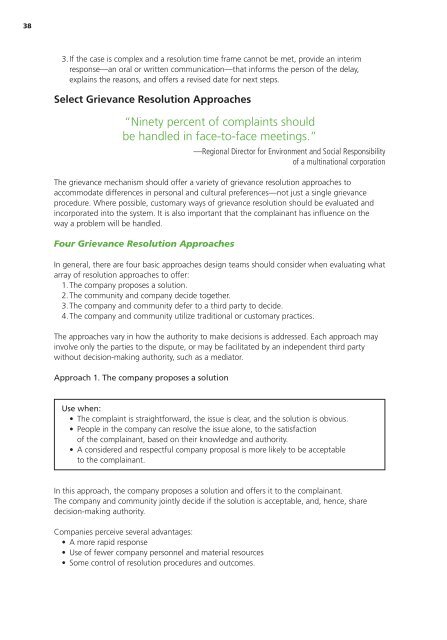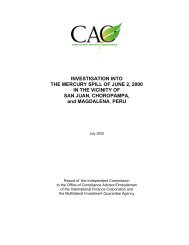A Guide to Designing and Implementing Grievance Mechanisms for ...
A Guide to Designing and Implementing Grievance Mechanisms for ...
A Guide to Designing and Implementing Grievance Mechanisms for ...
Create successful ePaper yourself
Turn your PDF publications into a flip-book with our unique Google optimized e-Paper software.
38<br />
3.If the case is complex <strong>and</strong> a resolution time frame cannot be met, provide an interim<br />
response—an oral or written communication—that in<strong>for</strong>ms the person of the delay,<br />
explains the reasons, <strong>and</strong> offers a revised date <strong>for</strong> next steps.<br />
Select <strong>Grievance</strong> Resolution Approaches<br />
“Ninety percent of complaints should<br />
be h<strong>and</strong>led in face-<strong>to</strong>-face meetings.”<br />
—Regional Direc<strong>to</strong>r <strong>for</strong> Environment <strong>and</strong> Social Responsibility<br />
of a multinational corporation<br />
The grievance mechanism should offer a variety of grievance resolution approaches <strong>to</strong><br />
accommodate differences in personal <strong>and</strong> cultural preferences—not just a single grievance<br />
procedure. Where possible, cus<strong>to</strong>mary ways of grievance resolution should be evaluated <strong>and</strong><br />
incorporated in<strong>to</strong> the system. It is also important that the complainant has influence on the<br />
way a problem will be h<strong>and</strong>led.<br />
Four <strong>Grievance</strong> Resolution Approaches<br />
In general, there are four basic approaches design teams should consider when evaluating what<br />
array of resolution approaches <strong>to</strong> offer:<br />
1.The company proposes a solution.<br />
2.The community <strong>and</strong> company decide <strong>to</strong>gether.<br />
3.The company <strong>and</strong> community defer <strong>to</strong> a third party <strong>to</strong> decide.<br />
4.The company <strong>and</strong> community utilize traditional or cus<strong>to</strong>mary practices.<br />
The approaches vary in how the authority <strong>to</strong> make decisions is addressed. Each approach may<br />
involve only the parties <strong>to</strong> the dispute, or may be facilitated by an independent third party<br />
without decision-making authority, such as a media<strong>to</strong>r.<br />
Approach 1. The company proposes a solution<br />
Use when:<br />
• The complaint is straight<strong>for</strong>ward, the issue is clear, <strong>and</strong> the solution is obvious.<br />
• People in the company can resolve the issue alone, <strong>to</strong> the satisfaction<br />
of the complainant, based on their knowledge <strong>and</strong> authority.<br />
• A considered <strong>and</strong> respectful company proposal is more likely <strong>to</strong> be acceptable<br />
<strong>to</strong> the complainant.<br />
In this approach, the company proposes a solution <strong>and</strong> offers it <strong>to</strong> the complainant.<br />
The company <strong>and</strong> community jointly decide if the solution is acceptable, <strong>and</strong>, hence, share<br />
decision-making authority.<br />
Companies perceive several advantages:<br />
• A more rapid response<br />
• Use of fewer company personnel <strong>and</strong> material resources<br />
• Some control of resolution procedures <strong>and</strong> outcomes.





